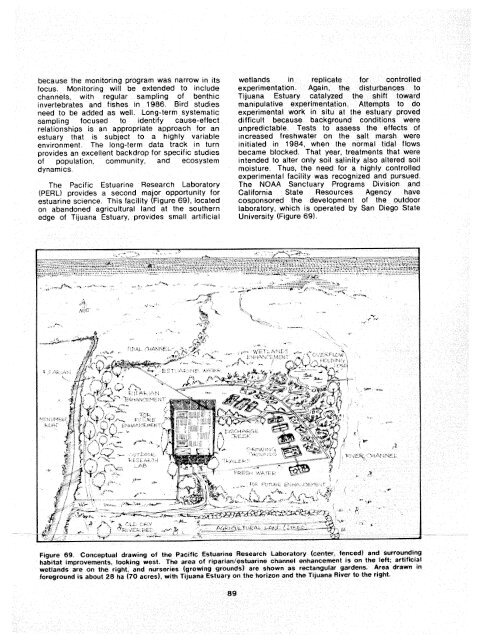The Ecology of Tijuana Estuary, California: An Estuarine Profile
The Ecology of Tijuana Estuary, California: An Estuarine Profile
The Ecology of Tijuana Estuary, California: An Estuarine Profile
Create successful ePaper yourself
Turn your PDF publications into a flip-book with our unique Google optimized e-Paper software.
ecause the monitoring program was narrow in its<br />
focus. Monitoring will be extended to include<br />
channeis, with regular sampling <strong>of</strong> benthic<br />
invertebrates and fishes in 1986. Bird studies<br />
need to be added as well. Long-term systematic<br />
sampling focused to identify cause-effect<br />
relationships is an appropriate approach for an<br />
estuary that is subject to a highly variable<br />
environment. <strong>The</strong> long-term data track in turn<br />
provides an excellent backdrop for specific studies<br />
<strong>of</strong> population, community, and ecosystem<br />
dynamics.<br />
<strong>The</strong> Pacific <strong>Estuarine</strong> Research Laboratory<br />
(PERLI provides a second major opportunity for<br />
estuarine science. This facility (Figure 691, iocated<br />
on abandoned agr~cultural land at the southern<br />
edge <strong>of</strong> <strong>Tijuana</strong> <strong>Estuary</strong>, provides small artificial<br />
wetlands in replicate for controlled<br />
experimentation, Again, the disturbances Xo<br />
<strong>Tijuana</strong> <strong>Estuary</strong> catalyzed the shift toward<br />
manipulative experimentation, Attempts to do<br />
experimental work in situ at the estuary proved<br />
difficult because background conditions were<br />
unpredictable. Tests to assess the effects <strong>of</strong><br />
increased freshwater on the salt marsh were<br />
initiated in 1984, when the normal tidal flows<br />
became blocked. That year, treatments that were<br />
intended to alter only soil salinity also altered soil<br />
maisture, Thus, the need far a highly controlled<br />
experimental facility was recognized and pursued.<br />
<strong>The</strong> NOAA Sanctuary Programs Division and<br />
<strong>California</strong> State Resources Agency have<br />
cosponsored the development <strong>of</strong> the outdoor<br />
laboratory, which is operated by San Oiego State<br />
University (Figure 69).

















